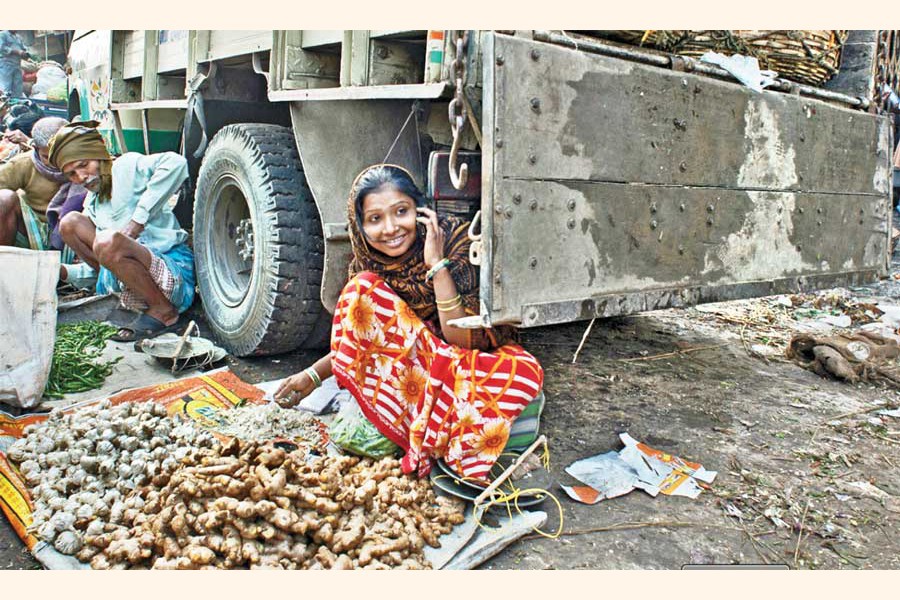
Reducing gender gap in financial inclusion
Pial Islam | Wednesday, 13 November 2019

 Anowara Begum, 35, is an employee of the local government in her rural community. She occasionally uses Mobile Financial Services (MFS) to send money to her relatives. However, she relies on her teenage son for MFS transactions. Although Anowara understands the benefits of using mobile money, she prefers using her son's MFS account because she thinks her son is more adept with technology than her. Anowara has owned a feature phone for 10 years and is comfortable using it.
Anowara Begum, 35, is an employee of the local government in her rural community. She occasionally uses Mobile Financial Services (MFS) to send money to her relatives. However, she relies on her teenage son for MFS transactions. Although Anowara understands the benefits of using mobile money, she prefers using her son's MFS account because she thinks her son is more adept with technology than her. Anowara has owned a feature phone for 10 years and is comfortable using it.
Bangladesh's mobile money market is one of the largest in the world. Nearly US$50 billion is transacted through 2.4 billion transactions by 50 million registered users annually in the country. However, women are disproportionately at a disadvantage. There are several factors that influence the gender gap that exists in mobile money in Bangladesh. First, there's a 25% gender gap in phone ownership. Second, there's a 13% gender gap in digital financial services (DFS) use in general (among those who use mobile money with the assistance of mobile money agents through over-the-counter (OTC) transactions). Third, there's a 14% gender gap in registered mobile money usage (among those who use their own mobile wallets for transactions). The compounding effect of these layers of gender gap is significant, especially among base of the pyramid (BOP) population segments.
In 2018 pi STRATEGY, a management consulting firm that specialises in innovation and strategy, conducted a study in collaboration with CGAP, an arm of the World Bank that is focused on financial inclusion, to understand the barriers for women to adopt digital financial services.The study focused on the usage of DFS by the BOP segment and used in-depth ethnographic research and human-centered design to develop multiple personas to better understand the challenges women faced.
Anowara Begum, described earlier, was classified as a Progressionist Female persona - someone who was aware of the opportunities around her and keen on learning about or availing those to improve her life.
Kamona Akter, 32, is the owner of a tailor shop. She has a personal source of income and has the authority over the financial decisions made at her household. She has an MFS account through which she receives remittance. Unlike Anowara, Kamona has owned a smartphone for some time and is comfortable using it. She also appreciates the benefits of using a mobile money wallet (instead of using OTC for transactions). Prior to our interview with Kamona, she had only used the unstructured supplementary service data (USSD) interface for conducting MFS transactions. However, when we introduced her to the smartphone app, she quickly learned the interface and navigated the functions of the app with ease. She had also seen a TV commercial describing navigation across one of the MFS apps, which made the process easier for her. Kamona Akhter is classified as an Aspirant Female persona - someone who was not only aware of the opportunities around her that will improve her life, but also explicitly seeks them out.
Anowara and Kamona are by no means alone. There are millions like them in Bangladesh and hundreds of millions like them around the world. In financial inclusion we often focus on closing the gender gap in account ownership as a means of empowering women. Yet, as many have pointed out, accounts by themselves do not lead to empowerment. Unless having a financial account comes with a compelling reason to use it, most women will not use their accounts to capture opportunities. Fortunately, even in countries where many women are financially excluded, women's financial behaviors tell us a lot about what use cases may help to empower them.
pi STRATEGY's 2018 work identified a number of use cases; and one of those use cases - leveraging social commerce to catalyse digital financial services - spurred significant interest at the global level and triggered further research to explore that use case in depth and across several countries.
Separate studies conducted by pi STRATEGY over the last five years generated evidence that social safety net programmes (SSNPs) that are targeted towards women also present a significant opportunity for women empowerment. In Bangladesh, Widow Allowance, Old Age Allowance Programme (with significant female coverage), and Primary & Secondary Student Stipend Programmes (where the mothers of the students are usually provided with the stipend) are examples of women-targeted SSNPs that collectively serve about 15 million women. Bangladesh government has been piloting digitisation of SSNP payments for a couple of years now. And in many of those cases, having the funds directly deposited into female recipients' mobile wallets have opened up a number of benefits, including greater control and better usage of those funds. A recent Harvard Kennedy School study corroborated these findings and showed that digital SSNP payments can provide women in developing nations with independent access to predictable income streams, and the arrival of a digital payment into a mobile wallet can give female recipients greater control over how the money will be used.
The potential impact of solving the gender gap in financial inclusion problem is significant and multi-faceted. A 2016 Harvard study found positive correlation between women's financial inclusion and their labor force participation.If more women participated in the labor force, it would directly impact GDP growth. A 2018 Mastercard Foundation study went as far to estimate that gender equality in financial inclusion and labor force participation by 2030 could raise global GDP by 3.6 percent and reduce the share of the global population living in extreme poverty by 0.5 percentage points. At a more micro level, studies have shown women take a more long-term approach to financial management than men. A 2009 pi STRATEGY study, conducted in partnership with the World Economic Forum, a global think-tank, found that while men invested their savings for immediate returns (e.g. buying a cow to sell the milk), women accumulated their savings for longer-term life goals (e.g. children's education). Greater financial inclusion of women can directly lead to more educated future generations, which in turn can catalyse increased productivity at a national level and contribute to positive impacts on the economy.
Solving wicked problems is never easy. The gender gap in financial inclusion is certainly one such wicked problem. It will require thoughtful and sustained effort from multiple dimensions and multiple stakeholders to create lasting impact.
..................................................
Pial Islam is Founder and Managing Partner at pi STRATEGY. He brings over 20 years of experience in management consulting at the international level and holds a graduate degree from Harvard University.
pial.islam@pistrategy.org